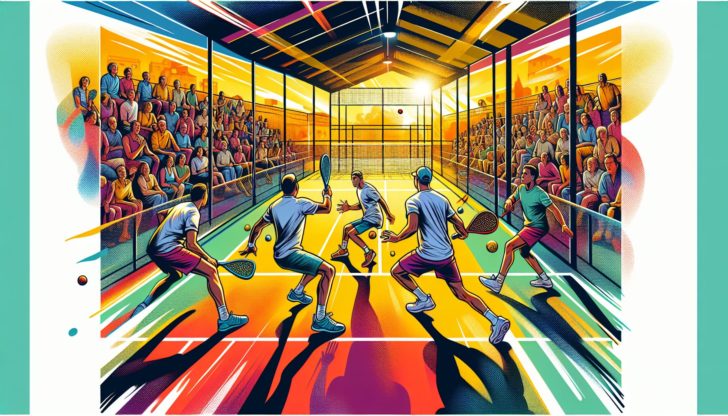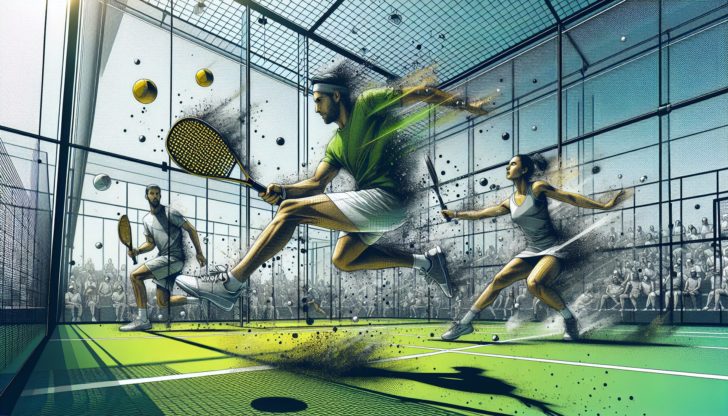What is padel sport, and why is it rapidly attracting players worldwide? Combining elements of tennis and squash, padel is played on a unique enclosed court, offering a social yet competitive environment. As you read on, you’ll grasp the basic rules, gear, and tactics to join millions in this fast-paced game. Whether you’re curious or serious about playing, get ready to dive into the world of padel.
Table of Contents
Key Takeaways
Padel is a popular racket sport played in doubles, combining elements of tennis and squash, and known for its social and less physically demanding nature, making it accessible to a broad range of players.
The game features unique equipment such as solid, perforated rackets and lower-pressure balls, and is played on enclosed courts with distinctive dimensions and materials, where using the walls tactically is part of gameplay.
Mastering Padel involves understanding its specific rules such as an underhand serve and the ball’s interaction with walls, as well as employing strategic play in doubles. Advanced play includes utilizing the glass walls for complex shots and tournaments offer competitive opportunities for players.
Discovering Padel: A Unique Racket Sport

Padel, also known as padel tennis, is a fascinating sport that is often played in doubles on an enclosed court, making it a distinctive blend of tennis and squash. This unique combination has led to Padel’s extensive global reach, attracting approximately 25 million players across over 90 countries, with many enthusiasts following the world padel tour.
While Padel’s gameplay offers a competitive edge, the sport’s strong social aspect enhances its appeal. This makes Padel not just a game, but a social event, creating a relaxed and engaging environment on the courts.
This unique combination of competitive play and sociability establishes Padel as a truly unique and enthralling racket sport, with the padel racket being a key component.
The Origins of Padel
Padel’s roots trace back to Mexico in the 1960s, where Enrique Corcuera adapted the tennis court to a smaller size and used wooden beach paddle bats suitable for the enclosed space. This innovative approach to racket sports combined elements of tennis and squash, giving birth to the unique sport we now know as Padel.
The sport quickly gained popularity, thanks to:
Enrique Corcuera’s friends who introduced Padel to Spain and Argentina
This exposure led to a surge in the sport’s growth and popularity in these countries
Propelling it onto the international stage and eventually, the professional Padel circuit.
Padel’s Appeal
The appeal of Padel lies not only in its unique gameplay but also in its accessibility to individuals of diverse ages and abilities. The smaller court size, slower pace, and strategic emphasis make Padel less physically demanding, making it an attractive sport for players of all ages.
Furthermore, Padel’s simplicity and the social nature of playing in doubles enhance its global appeal. The ease of picking up the game, combined with the social interaction it encourages, makes Padel a truly family-friendly sport.
Essential Components of Padel

As we delve deeper into the world of Padel, it’s crucial to understand its essential components, including the court and equipment. Unlike other racket sports, Padel rackets are:
Solid and made from composite materials, which distinctly sets them apart.
Slightly heavier and more compact than tennis rackets.
Typically perforated.
Constructed using high-quality materials such as carbon fiber or fiberglass.
Meanwhile, Padel balls, designed with less pressure than conventional tennis balls, add a unique twist to the game. The reduced pressure affects their bounce and speed, contributing to the game’s unique dynamics, which differ from those involving a tennis ball.
The Padel Court
A standard Padel court measures roughly 10 meters wide and 20 meters long, slightly smaller than a doubles tennis court. But what sets it apart is the unique feature of being an enclosed court surrounded by transparent or opaque rebound walls. This enclosure not only defines the boundaries of the court but also adds a unique strategic element to the gameplay. With the growing popularity of the sport, outdoor padel courts are becoming increasingly common.
The court surface can be made of a variety of materials, including concrete, cement, wood, synthetic material, or artificial turf. Regardless of the material, it must provide a consistent ball rebound. The walls of Padel courts utilize glass panels for back walls and service side walls, with metal mesh panels for other sides, again emphasizing the strategic element of rebound play.
Padel Equipment: Rackets and Balls
Padel rackets are unique:
They do not have strings and are solid
They feature holes
They are shorter than traditional tennis rackets
They have a distinct shape tailored for rebounding off the court’s walls
This unique design contributes to the uniqueness of the sport and its gameplay.
As for Padel balls, they offer a slower and lower bounce compared to tennis balls, influenced by the unique court dimensions and game rules. The slight differences in size and weight of Padel balls, being smaller and lighter, result in quicker gameplay that demands faster player reflexes.
Mastering Padel: Rules and Gameplay

Understanding the rules and gameplay is crucial to mastering Padel. Here are some key points to remember:
The scoring system follows the same as tennis, with points of 15, 30, 40, and game.
Sets are usually up to six games with at least a two-game lead required to win.
Matches are generally played to the best of three sets, further emulating the familiar tennis format.
However, Padel also introduces unique rules. The serve must be underhand and the ball cannot be struck above the waist. Also, in Padel, the ball must touch the ground before contact can be made with the walls or fences, except on the serve. These unique rules add a new dimension to the game, making Padel a distinctive and exciting sport.
Scoring and Serving
Being proficient in serving and understanding the scoring system are key to success in Padel. The serve in Padel is initiated using an underhand technique where the server stands in the back right corner of the serving box and must toss the ball at a height that is not too high. This unique serving style sets Padel apart from many other racket sports.
During the underhand serve, the ball must be hit diagonally into the opponent’s service box and is allowed to rebound off the walls. This expands the play area and adds a layer of complexity to the return, making serving in Padel a blend of precision, movement, and consistent stroke execution.
Doubles Play and Strategy
Padel is predominantly a doubles padel game, reflecting its social nature and the importance of strategic elements like positioning. The emphasis is on teamwork, and partnering up with someone to train and improve together can be highly beneficial.
This collaborative nature of Padel makes it a great sport for building strong team dynamics and improving communication skills.
Padel vs. Other Racket Sports

When compared to other racket sports, Padel stands out with its unique attributes. While it may often be confused with other racket sports like pickleball, paddle tennis (POP tennis), and platform tennis, Padel has distinctive characteristics that set it apart.
The smaller court size, use of walls for rebound play, different racket design, underhand serving, and slower balls with a lower bounce make Padel a sport of its own.
Key Differences in Gameplay
Unique gameplay elements further distinguish Padel from other racket sports. The glass walls are not just boundaries but integral parts of the court that can be used for tactical shots. This adds a unique twist to the game, making each shot a strategic decision.
Moreover, the Padel court’s smaller size allows for points to be played more quickly, often resulting in shorter game durations. The gameplay in Padel emphasizes strategic play, requiring players to be tactical, especially due to the presence of walls and the confined space of the court.
Advantages of Padel
Padel offers several advantages over other racket sports. It can be enjoyed by individuals of any age, making it a highly accessible game. Moreover, playing Padel can act as a stress reliever, as the game requires concentration that distracts from daily worries. Regular Padel play enhances muscle toning, strengthens cardiovascular activity, and can lead to increased endurance and physical resilience over time.
Additionally, Padel:
Encourages mental discipline and goal-setting
Fosters teamwork and cooperation
Makes it a fun and enjoyable activity, regardless of skill level
Facilitates socializing and networking opportunities as players can connect with a variety of individuals
Tips and Techniques for Padel Success
To enhance your Padel skills, we have compiled a series of tips and techniques that can be beneficial for your Padel success. These range from essential skills necessary for beginners to advanced strategies for competitive play. Practicing the five-shot rally exercise can improve endurance and ball control, while the ball retrieval exercise can enhance responsiveness and returning skills.
Moreover, here are some specific benefits of each drill:
Hitting balls sent to your forehand and backhand improves shot accuracy and control
The running and hitting drill improves mobility and shot execution
The wall bounce exercise can better hand-eye coordination and timing, and learning to anticipate the ball’s behavior after hitting the wall can effectively utilize the walls during play.
Essential Skills for Beginners
For beginners, choosing the right paddle racket that complements their playing style is essential for a successful entry into the sport. A proper racket grip is crucial for optimal serve and stroke execution, holding the paddle racket with both hands at a medium height around shoulder level.
Practicing the serve technique that includes precise ball placement, movement, and consistent stroke execution is essential. After the serve, beginners must focus on strategy, ball placement, speed, and adjusting play to maintain effective in-game tactics.
Advanced Strategies for Competitive Play
For advanced players, special shot techniques involve using the uniqueness of the glass walls to create varied ball bouncing angles, potentially surprising the opponent and gaining a competitive edge.
Advanced serving practice is also crucial, aiming to achieve consistent ball placement that challenges an opponent’s return capabilities during competitive matches.
Learn more, visit 5 Tips For Improving Your Padel Game.
Finding Padel Opportunities: Clubs, Classes, and Tournaments
Taking the leap into the exciting world of Padel involves finding the right opportunities to play, learn, and compete. Joining a local Padel club is beneficial for beginners as it builds social connections and encourages continuous skill improvement. You can find local Padel clubs for lessons by conducting a Google search with terms like ‘padel near me’.
For those interested in competing, Padel tournaments are listed on the websites of national Padel organizations. These platforms provide event details and registration information.
Joining a Padel Club
If you’re planning to join a Padel club, it’s important to understand the membership requirements, processes, and fees. You can find local Padel clubs by conducting an online search for clubs in your vicinity.
In the United States, new Padel players can seek assistance from the USPA, the national governing body for Padel, which provides information on how to become involved in the sport, including ways to join clubs and tournament participation.
Padel Classes for All Levels
Padel clubs offer various types of classes, including options for private or group lessons to accommodate different preferences and learning styles. These classes are structured according to skill level, providing tailored programs that range from initiation levels for newcomers to professional levels for highly experienced competitors.
Receiving coaching in Padel is instrumental in accelerating a player’s development by focusing on improving their technical skills, positioning on the court, and strategic understanding of the game.
Summary
In conclusion, Padel is a unique and engaging sport that skillfully blends elements of tennis and squash. Its smaller court, the use of walls for rebound play, distinctive equipment, and underhand serving make it a sport like no other. With its accessibility, social nature, and strategic gameplay, Padel is not just a game but a social event that caters to all ages and skill levels. Whether you’re a beginner or an advanced player, Padel offers numerous opportunities for learning, improving, and competing. So, why not give it a try? Who knows, Padel might just be your next favorite sport!
Frequently Asked Questions
Where did Padel originate?
Padel originated in Mexico in the 1960s.
How is scoring done in Padel?
In Padel, scoring follows the same system as tennis, with points of 15, 30, 40, and game. Sets typically consist of up to six games, and a two-game lead is needed to win.
How is serving done in Padel?
In Padel, serving is done using an underhand technique from the back right corner of the serving box, with the ball tossed at a moderate height.
How is Padel different from other racket sports?
Padel differs from other racket sports due to its smaller court size, use of walls for rebound play, distinct racket design, underhand serving, and slower balls with a lower bounce. These factors contribute to a unique playing experience and strategy.
How can I find Padel clubs in my area?
You can find Padel clubs in your area by conducting an online search for clubs nearby or seeking assistance from the USPA, the national governing body for Padel. Good luck!









